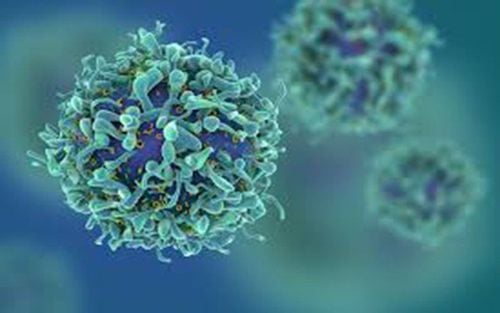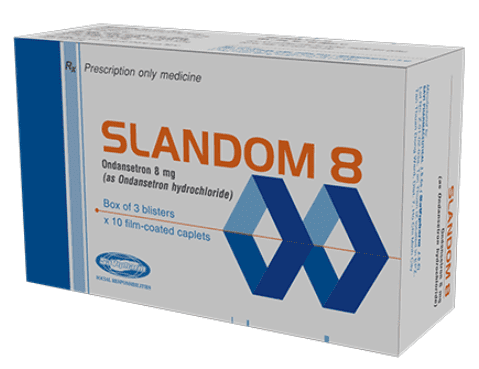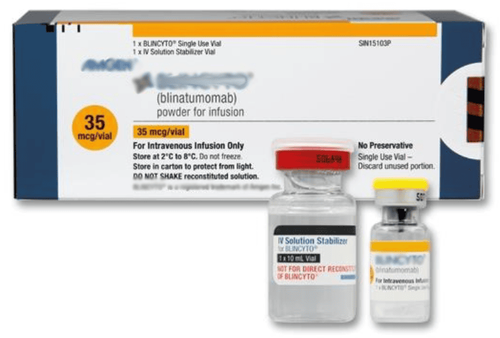This is an automatically translated article.
B-cell lymphoma refers to a group of cancers that attack the immune system. This is the most common type of non-Hodgkin lymphoma, usually starting in the lymph nodes but can also appear in other parts of the immune system, such as the spleen or bone marrow. As a result, doctors usually detect lymphoma in the lymphatic system, including the lymph nodes and lymph fluid, but sometimes, cancer can also be detected when malignant cells have migrated out. outside this system.
1. Types of B-cell lymphoma
B-cell lymphoma attacks the B cells, which are part of the immune system. Depending on the immune system, this disease is classified with several common diseases including:
Diffuse large B-cell lymphoma : More common in people over 60 years of age, this form usually begins as a lymph node rapidly growing lymph nodes - usually in the neck, armpits, or chest. The tumor grows rapidly and is highly malignant, but about 75% of patients have no signs of cancer after treatment. Follicular lymphoma: Also more common in older people, this type of lymphoma grows more slowly and is less aggressive. Although treatment can slow the progression of the disease, curing it is challenging. Sometimes, this form of lymphoma can develop into a fast-growing form of diffuse large B-cell lymphoma. Chronic lymphocytic leukemia and small-cell lymphoma: These cancers are so similar that doctors may consider them the same disease. They grow slowly and usually originate in the bone marrow or blood. Treatment cannot cure these cancers, but people can live a long time with the disease. Mantle cell lymphoma: This cancer is more common in men than in women and mainly affects people over 60 years of age. When the doctor finds out, the lymphoma may already be in several locations in the body, including the lymph nodes and spleen. Treatment is more difficult than many other types of B-cell lymphoma. Burkitt lymphoma: This rare type of lymphoma is more common in children than adults. These lymphoma cells usually start in the stomach, from there, can spread to the central nervous system and grow rapidly. Fortunately, more than half of patients can respond well to treatment. . Accordingly, the prognosis or survival rate depends on the type of cancer and the patient's overall health as well as the treatment plan being followed, the degree of response of the cancer, for example, lymphoma. cysts have a higher survival rate.
2. Stages of B . Cell Lymphoma
Doctors classify B-cell lymphoma according to where on the body it affects. More advanced lymphomas can cause more symptoms and are more difficult to cure than earlier-stage lymphomas.
Lugano staging For non-Hodgkin lymphoma, doctors tend to use the following staging system:
Stage 1: The lymphoma is present in only one lymph node or lymph organ , or in an area of a single organ outside the lymphatic system. Stage 2: Lymphoma exists on two or more lymph nodes or lymphoid organs on the same side (below or above) of the diaphragm, or covers a group of lymphoid organs and an adjacent organ. Stage 3: Lymphoma is present in many lymphatic organs on both sides of the diaphragm or above the diaphragm but has also moved to the spleen. Stage 4: The lymphoma has spread into at least one organ outside the lymphatic system. Binet staging Physicians use the Binet staging system for acute b lymphocytes or chronic leukemias:
Stage A: There are less than three affected areas of lymphatic tissue and the person patients without thrombocytopenia or anemia. Stage B: The person has three or more areas of lymphatic tissue affected but does not have thrombocytopenia or anemia. Stage C: The person has anemia or thrombocytopenia with any number of areas of lymph tissue affected. Doctors classify B-cell lymphoma according to how far it affects the body. More advanced lymphomas can cause more symptoms and are more difficult to cure than earlier-stage lymphomas.
Lugano staging For non-Hodgkin lymphoma, doctors tend to use the following staging system:
Stage 1: The lymphoma is present in only one lymph node or lymph organ , or in an area of a single organ outside the lymphatic system. Stage 2: Lymphoma exists on two or more lymph nodes or lymphoid organs on the same side (below or above) of the diaphragm, or covers a group of lymphoid organs and an adjacent organ. Stage 3: Lymphoma is present in many lymphatic organs on both sides of the diaphragm or above the diaphragm but has also moved to the spleen. Stage 4: The lymphoma has spread into at least one organ outside the lymphatic system. Binet staging Physicians use the Binet staging system for acute b lymphocytes or chronic leukemias:
Stage A: There are less than three affected areas of lymphatic tissue and the person patients without thrombocytopenia or anemia. Stage B: The person has three or more areas of lymphatic tissue affected but does not have thrombocytopenia or anemia. Stage C: The person has anemia or thrombocytopenia with any number of areas of lymph tissue affected.
3. Pathogenic causes of B . cell lymphoma
There is no single cause that accounts for all cases of B-cell lymphoma, and some people with the disease have no known risk factors. In general, doctors think that the interaction of a number of different factors can alter the stability of the immune system, possibly leading to lymphoma. These factors include:
Environmental factors Immune system problems, such as an autoimmune disease that causes the immune system to attack healthy tissue, such as rheumatoid arthritis, may increase the risk of disease.
Chronic infections, such as HIV . Research has demonstrated that the disease is associated with certain viruses, including the Epstein-Barr virus that causes mononucleosis, with higher rates of lymphoma.
Immunosuppressive conditions: Conditions that weaken the immune system, such as HIV, can lead to lymphoma and increase the risk of more severe forms of the disease. Medication: Certain medications, including a class of immunosuppressive drugs known as TNF antagonists, can increase your risk of the disease. Chemicals: Exposure to certain toxins and pesticides can increase the risk of lymphoma. Age: Over 60 years of age have a higher risk of developing the disease.

Tuổi già cũng có thể làm tăng nguy cơ mắc ung thư bạch huyết tế bào B.
4. Symptoms of B-cell lymphoma
Symptoms of B-cell lymphoma vary greatly depending on the type as well as the stage of the disease when detected. Many people with lymphoma have no symptoms while others experience various problems.
Pain: Some people have pain at the site of the lymphoma. For example, a person with lymphoma that started in the chest may experience chest pain. Swollen lymph nodes: Lymphoma usually begins as a swollen or painful lymph node. It is important to ask your doctor about any lymph nodes that have not returned to their normal size after an infection. Symptoms of infection: Some people have symptoms similar to those of an infection, such as fever, chills, weakness, or fatigue. Unintentional weight loss: Some people lose weight quickly, in a short period of time without consciously adopting lifestyle changes.
5. How to Treat B-cell Lymphoma
Treatment regimens vary depending on the type and stage of B-cell lymphoma and the patient's overall health. For some patients, the risks of some treatments may outweigh the potential benefits. Meanwhile, for others, immediate aggressive treatment can cure cancer and help people live longer, healthier lives.
Some treatment options for B-cell lymphoma include:
Chemotherapy: Chemotherapy can shrink cancer cells but can also damage healthy cells. Methotrexate is an effective chemotherapy drug for many types of B-cell lymphoma. Immunotherapy: Immunotherapy uses drugs to reorient the immune system to fight cancer. Radiation therapy: Like chemotherapy, radiation therapy can kill cancer cells as well as healthy cells. Stem cell transplant: In some types of cancer, including those that recur or are resistant to treatment, a stem cell transplant can reduce symptoms or even cure the cancer. Supportive therapy: Doctors may recommend additional therapy to relieve symptoms, as well as side effects of treatment. For example, your doctor may prescribe an anti-nausea medication to help relieve chemotherapy-related nausea. In summary, the diagnosis, classification, and staging of B-cell lymphoma are pivotal in the management of this pathology. Fortunately, however, most forms of B-cell lymphoma respond well to treatment. Still, prompt diagnosis and early treatment improve outcomes dramatically, even in people with more advanced forms of cancer. So it's important to know that don't delay seeing your doctor about swollen lymph nodes or any other possible cancer symptoms.
Please dial HOTLINE for more information or register for an appointment HERE. Download MyVinmec app to make appointments faster and to manage your bookings easily.
Reference articles: uptodate.com, cancer.org, medicalnewstoday.com, lymphoma-action.org.uk, webmd.com, bthh.org.vn, mountelizabeth.com.sg












